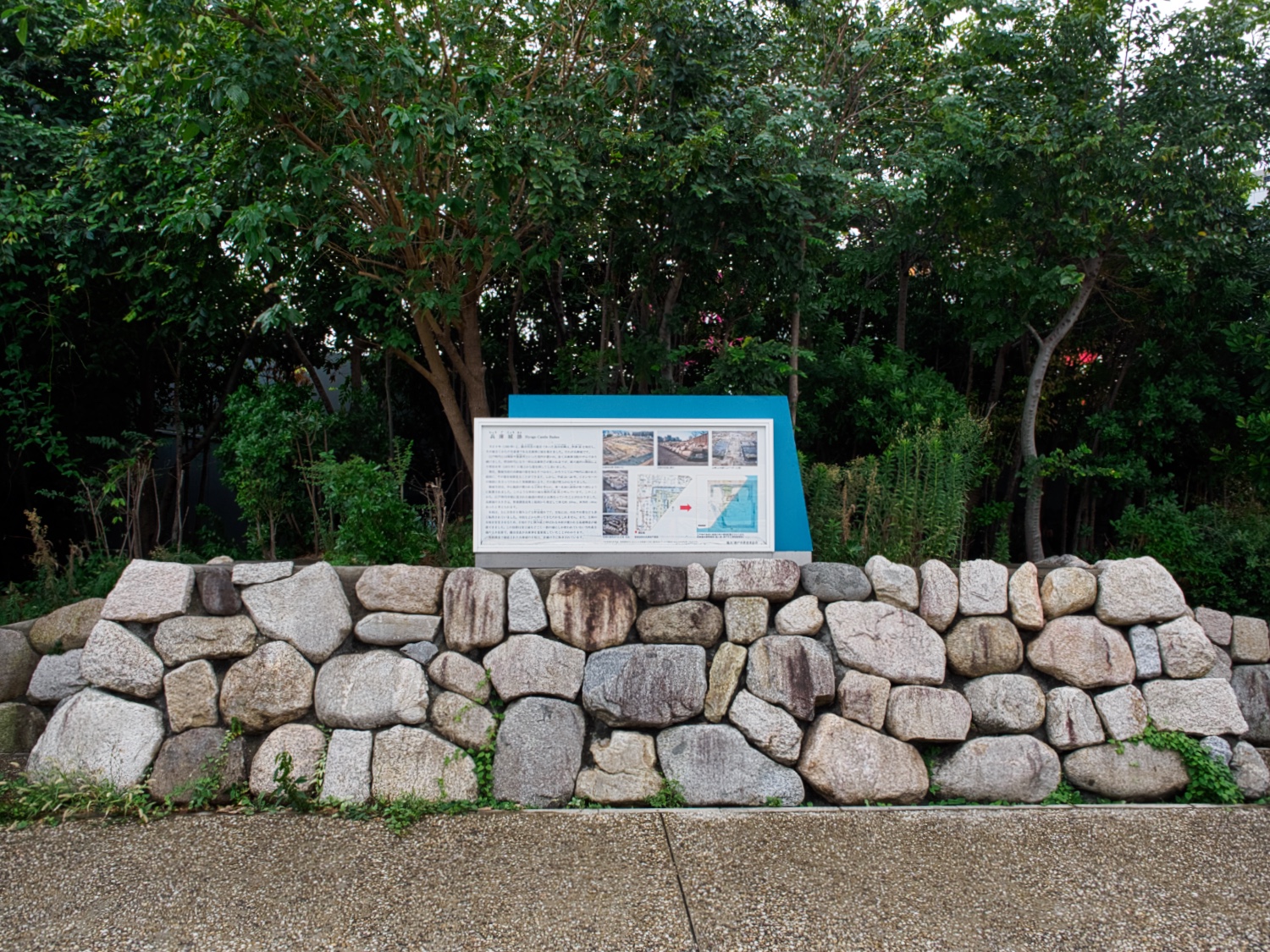Loading map...
{"format":"leaflet","minzoom":false,"maxzoom":false,"limit":500,"offset":0,"link":"all","sort":["order"],"order":[],"headers":"show","mainlabel":"","intro":"","outro":"","searchlabel":"... further results","default":"","import-annotation":false,"width":"auto","height":"350px","centre":false,"title":"","label":"","icon":"Darkred18.png","lines":[],"polygons":[],"circles":[],"rectangles":[],"copycoords":false,"static":false,"zoom":false,"defzoom":14,"layers":["Esri.WorldTopoMap"],"image layers":[],"overlays":[],"resizable":false,"fullscreen":false,"scrollwheelzoom":true,"cluster":false,"clustermaxzoom":20,"clusterzoomonclick":true,"clustermaxradius":80,"clusterspiderfy":true,"geojson":"","clicktarget":"","showtitle":false,"hidenamespace":true,"template":"InfoWindowProfile","userparam":"","activeicon":"","pagelabel":false,"ajaxcoordproperty":"","ajaxquery":"","locations":[{"text":"\u003Cdiv style=\"width:150px\"\u003E\n\u003Cp\u003E\u003Ca href=\"/view/File:Hyogojo7.jpg\" class=\"image\"\u003E\u003Cimg alt=\"Hyogojo7.jpg\" src=\"../images/thumb/9/9c/Hyogojo7.jpg/125px-Hyogojo7.jpg\" decoding=\"async\" width=\"125\" height=\"94\" srcset=\"../images/thumb/9/9c/Hyogojo7.jpg/188px-Hyogojo7.jpg 1.5x, ../images/thumb/9/9c/Hyogojo7.jpg/250px-Hyogojo7.jpg 2x\" data-file-width=\"1500\" data-file-height=\"1125\" /\u003E\u003C/a\u003E\u003C!--MW-PAGEIMAGES-CANDIDATE-0--\u003E\n\u003C/p\u003E\n\u003C/div\u003E","title":"","link":"","lat":34.66685,"lon":135.17477,"icon":"../images/0/06/Darkred18.png"},{"text":"\u003Cdiv style=\"width:150px\"\u003E\n\u003Cp\u003E\u003Ca href=\"/view/File:Hyogojo8.jpg\" class=\"image\"\u003E\u003Cimg alt=\"Hyogojo8.jpg\" src=\"../images/thumb/2/2d/Hyogojo8.jpg/125px-Hyogojo8.jpg\" decoding=\"async\" width=\"125\" height=\"94\" srcset=\"../images/thumb/2/2d/Hyogojo8.jpg/188px-Hyogojo8.jpg 1.5x, ../images/thumb/2/2d/Hyogojo8.jpg/250px-Hyogojo8.jpg 2x\" data-file-width=\"1500\" data-file-height=\"1124\" /\u003E\u003C/a\u003E\u003C!--MW-PAGEIMAGES-CANDIDATE-1--\u003E\n\u003C/p\u003E\n\u003C/div\u003E","title":"","link":"","lat":34.66673,"lon":135.17402,"icon":"../images/0/06/Darkred18.png"},{"text":"\u003Cdiv style=\"width:150px\"\u003E\n\u003Cp\u003E\u003Ca href=\"/view/File:Hyogojo15.jpg\" class=\"image\"\u003E\u003Cimg alt=\"Hyogojo15.jpg\" src=\"../images/thumb/6/6b/Hyogojo15.jpg/125px-Hyogojo15.jpg\" decoding=\"async\" width=\"125\" height=\"94\" srcset=\"../images/thumb/6/6b/Hyogojo15.jpg/188px-Hyogojo15.jpg 1.5x, ../images/thumb/6/6b/Hyogojo15.jpg/250px-Hyogojo15.jpg 2x\" data-file-width=\"1500\" data-file-height=\"1125\" /\u003E\u003C/a\u003E\u003C!--MW-PAGEIMAGES-CANDIDATE-2--\u003E\n\u003C/p\u003E\n\u003C/div\u003E","title":"","link":"","lat":34.66552,"lon":135.17551,"icon":"../images/0/06/Darkred18.png"},{"text":"\u003Cdiv style=\"width:150px\"\u003E\n\u003Cp\u003E\u003Ca href=\"/view/File:Hyogojo14.jpg\" class=\"image\"\u003E\u003Cimg alt=\"Hyogojo14.jpg\" src=\"../images/thumb/1/1e/Hyogojo14.jpg/125px-Hyogojo14.jpg\" decoding=\"async\" width=\"125\" height=\"94\" srcset=\"../images/thumb/1/1e/Hyogojo14.jpg/188px-Hyogojo14.jpg 1.5x, ../images/thumb/1/1e/Hyogojo14.jpg/250px-Hyogojo14.jpg 2x\" data-file-width=\"1500\" data-file-height=\"1125\" /\u003E\u003C/a\u003E\u003C!--MW-PAGEIMAGES-CANDIDATE-3--\u003E\n\u003C/p\u003E\n\u003C/div\u003E","title":"","link":"","lat":34.66553,"lon":135.17552,"icon":"../images/0/06/Darkred18.png"},{"text":"\u003Cdiv style=\"width:150px\"\u003E\n\u003Cp\u003E\u003Ca href=\"/view/File:Hyogokencho1.jpg\" class=\"image\"\u003E\u003Cimg alt=\"Hyogokencho1.jpg\" src=\"../images/thumb/5/59/Hyogokencho1.jpg/125px-Hyogokencho1.jpg\" decoding=\"async\" width=\"125\" height=\"94\" srcset=\"../images/thumb/5/59/Hyogokencho1.jpg/188px-Hyogokencho1.jpg 1.5x, ../images/thumb/5/59/Hyogokencho1.jpg/250px-Hyogokencho1.jpg 2x\" data-file-width=\"1500\" data-file-height=\"1125\" /\u003E\u003C/a\u003E\u003C!--MW-PAGEIMAGES-CANDIDATE-4--\u003E\n\u003C/p\u003E\n\u003C/div\u003E","title":"","link":"","lat":34.663852,"lon":135.175008,"icon":"../images/0/06/Darkred18.png"},{"text":"\u003Cdiv style=\"width:150px\"\u003E\n\u003Cp\u003E\u003Ca href=\"/view/File:Hyogokencho2.jpg\" class=\"image\"\u003E\u003Cimg alt=\"Hyogokencho2.jpg\" src=\"../images/thumb/c/cb/Hyogokencho2.jpg/125px-Hyogokencho2.jpg\" decoding=\"async\" width=\"125\" height=\"94\" srcset=\"../images/thumb/c/cb/Hyogokencho2.jpg/188px-Hyogokencho2.jpg 1.5x, ../images/thumb/c/cb/Hyogokencho2.jpg/250px-Hyogokencho2.jpg 2x\" data-file-width=\"1500\" data-file-height=\"1125\" /\u003E\u003C/a\u003E\u003C!--MW-PAGEIMAGES-CANDIDATE-5--\u003E\n\u003C/p\u003E\n\u003C/div\u003E","title":"","link":"","lat":34.663843,"lon":135.175283,"icon":"../images/0/06/Darkred18.png"},{"text":"\u003Cdiv style=\"width:150px\"\u003E\n\u003Cp\u003E\u003Ca href=\"/view/File:Hyogojo2.jpg\" class=\"image\"\u003E\u003Cimg alt=\"Hyogojo2.jpg\" src=\"../images/thumb/e/e8/Hyogojo2.jpg/125px-Hyogojo2.jpg\" decoding=\"async\" width=\"125\" height=\"94\" srcset=\"../images/thumb/e/e8/Hyogojo2.jpg/188px-Hyogojo2.jpg 1.5x, ../images/thumb/e/e8/Hyogojo2.jpg/250px-Hyogojo2.jpg 2x\" data-file-width=\"1500\" data-file-height=\"1125\" /\u003E\u003C/a\u003E\u003C!--MW-PAGEIMAGES-CANDIDATE-6--\u003E\n\u003C/p\u003E\n\u003C/div\u003E","title":"","link":"","lat":34.666925,"lon":135.175532,"icon":"../images/0/06/Darkred18.png"},{"text":"\u003Cdiv style=\"width:150px\"\u003E\n\u003Cp\u003E\u003Ca href=\"/view/File:Hyogojo1.jpg\" class=\"image\"\u003E\u003Cimg alt=\"Hyogojo1.jpg\" src=\"../images/thumb/9/99/Hyogojo1.jpg/125px-Hyogojo1.jpg\" decoding=\"async\" width=\"125\" height=\"94\" srcset=\"../images/thumb/9/99/Hyogojo1.jpg/188px-Hyogojo1.jpg 1.5x, ../images/thumb/9/99/Hyogojo1.jpg/250px-Hyogojo1.jpg 2x\" data-file-width=\"1500\" data-file-height=\"1125\" /\u003E\u003C/a\u003E\u003C!--MW-PAGEIMAGES-CANDIDATE-7--\u003E\n\u003C/p\u003E\n\u003C/div\u003E","title":"","link":"","lat":34.66693,"lon":135.175532,"icon":"../images/0/06/Darkred18.png"},{"text":"\u003Cdiv style=\"width:150px\"\u003E\n\u003Cp\u003E\u003Ca href=\"/view/File:Hyogokencho3.jpg\" class=\"image\"\u003E\u003Cimg alt=\"Hyogokencho3.jpg\" src=\"../images/thumb/c/cf/Hyogokencho3.jpg/125px-Hyogokencho3.jpg\" decoding=\"async\" width=\"125\" height=\"94\" srcset=\"../images/thumb/c/cf/Hyogokencho3.jpg/188px-Hyogokencho3.jpg 1.5x, ../images/thumb/c/cf/Hyogokencho3.jpg/250px-Hyogokencho3.jpg 2x\" data-file-width=\"1500\" data-file-height=\"1125\" /\u003E\u003C/a\u003E\u003C!--MW-PAGEIMAGES-CANDIDATE-8--\u003E\n\u003C/p\u003E\n\u003C/div\u003E","title":"","link":"","lat":34.664033,"lon":135.175308,"icon":"../images/0/06/Darkred18.png"},{"text":"\u003Cdiv style=\"width:150px\"\u003E\n\u003Cp\u003E\u003Ca href=\"/view/File:Hyogojo4.jpg\" class=\"image\"\u003E\u003Cimg alt=\"Hyogojo4.jpg\" src=\"../images/thumb/f/f3/Hyogojo4.jpg/125px-Hyogojo4.jpg\" decoding=\"async\" width=\"125\" height=\"94\" srcset=\"../images/thumb/f/f3/Hyogojo4.jpg/188px-Hyogojo4.jpg 1.5x, ../images/thumb/f/f3/Hyogojo4.jpg/250px-Hyogojo4.jpg 2x\" data-file-width=\"1500\" data-file-height=\"1125\" /\u003E\u003C/a\u003E\u003C!--MW-PAGEIMAGES-CANDIDATE-9--\u003E\n\u003C/p\u003E\n\u003C/div\u003E","title":"","link":"","lat":34.666912,"lon":135.175545,"icon":"../images/0/06/Darkred18.png"},{"text":"\u003Cdiv style=\"width:150px\"\u003E\n\u003Cp\u003E\u003Ca href=\"/view/File:Hyogokencho4.jpg\" class=\"image\"\u003E\u003Cimg alt=\"Hyogokencho4.jpg\" src=\"../images/thumb/a/ae/Hyogokencho4.jpg/125px-Hyogokencho4.jpg\" decoding=\"async\" width=\"125\" height=\"94\" srcset=\"../images/thumb/a/ae/Hyogokencho4.jpg/188px-Hyogokencho4.jpg 1.5x, ../images/thumb/a/ae/Hyogokencho4.jpg/250px-Hyogokencho4.jpg 2x\" data-file-width=\"1500\" data-file-height=\"1125\" /\u003E\u003C/a\u003E\u003C!--MW-PAGEIMAGES-CANDIDATE-10--\u003E\n\u003C/p\u003E\n\u003C/div\u003E","title":"","link":"","lat":34.664157,"lon":135.175253,"icon":"../images/0/06/Darkred18.png"},{"text":"\u003Cdiv style=\"width:150px\"\u003E\n\u003Cp\u003E\u003Ca href=\"/view/File:Hyogojo5.jpg\" class=\"image\"\u003E\u003Cimg alt=\"Hyogojo5.jpg\" src=\"../images/thumb/3/3b/Hyogojo5.jpg/125px-Hyogojo5.jpg\" decoding=\"async\" width=\"125\" height=\"94\" srcset=\"../images/thumb/3/3b/Hyogojo5.jpg/188px-Hyogojo5.jpg 1.5x, ../images/thumb/3/3b/Hyogojo5.jpg/250px-Hyogojo5.jpg 2x\" data-file-width=\"1500\" data-file-height=\"1124\" /\u003E\u003C/a\u003E\u003C!--MW-PAGEIMAGES-CANDIDATE-11--\u003E\n\u003C/p\u003E\n\u003C/div\u003E","title":"","link":"","lat":34.666903,"lon":135.175548,"icon":"../images/0/06/Darkred18.png"},{"text":"\u003Cdiv style=\"width:150px\"\u003E\n\u003Cp\u003E\u003Ca href=\"/view/File:Hyogokencho5.jpg\" class=\"image\"\u003E\u003Cimg alt=\"Hyogokencho5.jpg\" src=\"../images/thumb/5/59/Hyogokencho5.jpg/125px-Hyogokencho5.jpg\" decoding=\"async\" width=\"125\" height=\"94\" srcset=\"../images/thumb/5/59/Hyogokencho5.jpg/188px-Hyogokencho5.jpg 1.5x, ../images/thumb/5/59/Hyogokencho5.jpg/250px-Hyogokencho5.jpg 2x\" data-file-width=\"1500\" data-file-height=\"1125\" /\u003E\u003C/a\u003E\u003C!--MW-PAGEIMAGES-CANDIDATE-12--\u003E\n\u003C/p\u003E\n\u003C/div\u003E","title":"","link":"","lat":34.66396,"lon":135.175373,"icon":"../images/0/06/Darkred18.png"},{"text":"\u003Cdiv style=\"width:150px\"\u003E\n\u003Cp\u003E\u003Ca href=\"/view/File:Hyogojo6.jpg\" class=\"image\"\u003E\u003Cimg alt=\"Hyogojo6.jpg\" src=\"../images/thumb/4/42/Hyogojo6.jpg/125px-Hyogojo6.jpg\" decoding=\"async\" width=\"125\" height=\"94\" srcset=\"../images/thumb/4/42/Hyogojo6.jpg/188px-Hyogojo6.jpg 1.5x, ../images/thumb/4/42/Hyogojo6.jpg/250px-Hyogojo6.jpg 2x\" data-file-width=\"1500\" data-file-height=\"1125\" /\u003E\u003C/a\u003E\u003C!--MW-PAGEIMAGES-CANDIDATE-13--\u003E\n\u003C/p\u003E\n\u003C/div\u003E","title":"","link":"","lat":34.666902,"lon":135.175553,"icon":"../images/0/06/Darkred18.png"},{"text":"\u003Cdiv style=\"width:150px\"\u003E\n\u003Cp\u003E\u003Ca href=\"/view/File:Hyogokencho6.jpg\" class=\"image\"\u003E\u003Cimg alt=\"Hyogokencho6.jpg\" src=\"../images/thumb/2/21/Hyogokencho6.jpg/125px-Hyogokencho6.jpg\" decoding=\"async\" width=\"125\" height=\"94\" srcset=\"../images/thumb/2/21/Hyogokencho6.jpg/188px-Hyogokencho6.jpg 1.5x, ../images/thumb/2/21/Hyogokencho6.jpg/250px-Hyogokencho6.jpg 2x\" data-file-width=\"1500\" data-file-height=\"1125\" /\u003E\u003C/a\u003E\u003C!--MW-PAGEIMAGES-CANDIDATE-14--\u003E\n\u003C/p\u003E\n\u003C/div\u003E","title":"","link":"","lat":34.66408,"lon":135.174883,"icon":"../images/0/06/Darkred18.png"},{"text":"\u003Cdiv style=\"width:150px\"\u003E\n\u003Cp\u003E\u003Ca href=\"/view/File:Hyogokencho7.jpg\" class=\"image\"\u003E\u003Cimg alt=\"Hyogokencho7.jpg\" src=\"../images/thumb/6/63/Hyogokencho7.jpg/125px-Hyogokencho7.jpg\" decoding=\"async\" width=\"125\" height=\"94\" srcset=\"../images/thumb/6/63/Hyogokencho7.jpg/188px-Hyogokencho7.jpg 1.5x, ../images/thumb/6/63/Hyogokencho7.jpg/250px-Hyogokencho7.jpg 2x\" data-file-width=\"1500\" data-file-height=\"1125\" /\u003E\u003C/a\u003E\u003C!--MW-PAGEIMAGES-CANDIDATE-15--\u003E\n\u003C/p\u003E\n\u003C/div\u003E","title":"","link":"","lat":34.66407,"lon":135.174868,"icon":"../images/0/06/Darkred18.png"},{"text":"\u003Cdiv style=\"width:150px\"\u003E\n\u003Cp\u003E\u003Ca href=\"/view/File:Hyogokencho8.jpg\" class=\"image\"\u003E\u003Cimg alt=\"Hyogokencho8.jpg\" src=\"../images/thumb/4/4a/Hyogokencho8.jpg/125px-Hyogokencho8.jpg\" decoding=\"async\" width=\"125\" height=\"94\" srcset=\"../images/thumb/4/4a/Hyogokencho8.jpg/188px-Hyogokencho8.jpg 1.5x, ../images/thumb/4/4a/Hyogokencho8.jpg/250px-Hyogokencho8.jpg 2x\" data-file-width=\"1500\" data-file-height=\"1125\" /\u003E\u003C/a\u003E\u003C!--MW-PAGEIMAGES-CANDIDATE-16--\u003E\n\u003C/p\u003E\n\u003C/div\u003E","title":"","link":"","lat":34.664075,"lon":135.174878,"icon":"../images/0/06/Darkred18.png"},{"text":"\u003Cdiv style=\"width:150px\"\u003E\n\u003Cp\u003E\u003Ca href=\"/view/File:Hyogokencho9.jpg\" class=\"image\"\u003E\u003Cimg alt=\"Hyogokencho9.jpg\" src=\"../images/thumb/f/f3/Hyogokencho9.jpg/125px-Hyogokencho9.jpg\" decoding=\"async\" width=\"125\" height=\"94\" srcset=\"../images/thumb/f/f3/Hyogokencho9.jpg/188px-Hyogokencho9.jpg 1.5x, ../images/thumb/f/f3/Hyogokencho9.jpg/250px-Hyogokencho9.jpg 2x\" data-file-width=\"1500\" data-file-height=\"1125\" /\u003E\u003C/a\u003E\u003C!--MW-PAGEIMAGES-CANDIDATE-17--\u003E\n\u003C/p\u003E\n\u003C/div\u003E","title":"","link":"","lat":34.663892,"lon":135.174813,"icon":"../images/0/06/Darkred18.png"},{"text":"\u003Cdiv style=\"width:150px\"\u003E\n\u003Cp\u003E\u003Ca href=\"/view/File:Hyogokencho10.jpg\" class=\"image\"\u003E\u003Cimg alt=\"Hyogokencho10.jpg\" src=\"../images/thumb/e/ec/Hyogokencho10.jpg/125px-Hyogokencho10.jpg\" decoding=\"async\" width=\"125\" height=\"94\" srcset=\"../images/thumb/e/ec/Hyogokencho10.jpg/188px-Hyogokencho10.jpg 1.5x, ../images/thumb/e/ec/Hyogokencho10.jpg/250px-Hyogokencho10.jpg 2x\" data-file-width=\"1500\" data-file-height=\"1125\" /\u003E\u003C/a\u003E\u003C!--MW-PAGEIMAGES-CANDIDATE-18--\u003E\n\u003C/p\u003E\n\u003C/div\u003E","title":"","link":"","lat":34.66389,"lon":135.174835,"icon":"../images/0/06/Darkred18.png"},{"text":"\u003Cdiv style=\"width:150px\"\u003E\n\u003Cp\u003E\u003Ca href=\"/view/File:Hyogojo3.jpg\" class=\"image\"\u003E\u003Cimg alt=\"Hyogojo3.jpg\" src=\"../images/thumb/3/3e/Hyogojo3.jpg/125px-Hyogojo3.jpg\" decoding=\"async\" width=\"125\" height=\"94\" srcset=\"../images/thumb/3/3e/Hyogojo3.jpg/188px-Hyogojo3.jpg 1.5x, ../images/thumb/3/3e/Hyogojo3.jpg/250px-Hyogojo3.jpg 2x\" data-file-width=\"1500\" data-file-height=\"1125\" /\u003E\u003C/a\u003E\u003C!--MW-PAGEIMAGES-CANDIDATE-19--\u003E\n\u003C/p\u003E\n\u003C/div\u003E","title":"","link":"","lat":34.666922,"lon":135.175538,"icon":"../images/0/06/Darkred18.png"},{"text":"\u003Cdiv style=\"width:150px\"\u003E\n\u003Cp\u003E\u003Ca href=\"/view/File:Hyogokencho11.jpg\" class=\"image\"\u003E\u003Cimg alt=\"Hyogokencho11.jpg\" src=\"../images/thumb/e/e3/Hyogokencho11.jpg/125px-Hyogokencho11.jpg\" decoding=\"async\" width=\"125\" height=\"94\" srcset=\"../images/thumb/e/e3/Hyogokencho11.jpg/188px-Hyogokencho11.jpg 1.5x, ../images/thumb/e/e3/Hyogokencho11.jpg/250px-Hyogokencho11.jpg 2x\" data-file-width=\"1500\" data-file-height=\"1125\" /\u003E\u003C/a\u003E\u003C!--MW-PAGEIMAGES-CANDIDATE-20--\u003E\n\u003C/p\u003E\n\u003C/div\u003E","title":"","link":"","lat":34.664042,"lon":135.174815,"icon":"../images/0/06/Darkred18.png"},{"text":"\u003Cdiv style=\"width:150px\"\u003E\n\u003Cp\u003E\u003Ca href=\"/view/File:Hyogojo12.jpg\" class=\"image\"\u003E\u003Cimg alt=\"Hyogojo12.jpg\" src=\"../images/thumb/2/2c/Hyogojo12.jpg/125px-Hyogojo12.jpg\" decoding=\"async\" width=\"125\" height=\"94\" srcset=\"../images/thumb/2/2c/Hyogojo12.jpg/188px-Hyogojo12.jpg 1.5x, ../images/thumb/2/2c/Hyogojo12.jpg/250px-Hyogojo12.jpg 2x\" data-file-width=\"1500\" data-file-height=\"1125\" /\u003E\u003C/a\u003E\u003C!--MW-PAGEIMAGES-CANDIDATE-21--\u003E\n\u003C/p\u003E\n\u003C/div\u003E","title":"","link":"","lat":34.66396,"lon":135.17524,"icon":"../images/0/06/Darkred18.png"},{"text":"\u003Cdiv style=\"width:150px\"\u003E\n\u003Cp\u003E\u003Ca href=\"/view/File:Hyogokencho12.jpg\" class=\"image\"\u003E\u003Cimg alt=\"Hyogokencho12.jpg\" src=\"../images/thumb/f/fe/Hyogokencho12.jpg/125px-Hyogokencho12.jpg\" decoding=\"async\" width=\"125\" height=\"94\" srcset=\"../images/thumb/f/fe/Hyogokencho12.jpg/188px-Hyogokencho12.jpg 1.5x, ../images/thumb/f/fe/Hyogokencho12.jpg/250px-Hyogokencho12.jpg 2x\" data-file-width=\"1500\" data-file-height=\"1125\" /\u003E\u003C/a\u003E\u003C!--MW-PAGEIMAGES-CANDIDATE-22--\u003E\n\u003C/p\u003E\n\u003C/div\u003E","title":"","link":"","lat":34.66406,"lon":135.17483,"icon":"../images/0/06/Darkred18.png"},{"text":"\u003Cdiv style=\"width:150px\"\u003E\n\u003Cp\u003E\u003Ca href=\"/view/File:Hyogokencho13.jpg\" class=\"image\"\u003E\u003Cimg alt=\"Hyogokencho13.jpg\" src=\"../images/thumb/3/3d/Hyogokencho13.jpg/125px-Hyogokencho13.jpg\" decoding=\"async\" width=\"125\" height=\"94\" srcset=\"../images/thumb/3/3d/Hyogokencho13.jpg/188px-Hyogokencho13.jpg 1.5x, ../images/thumb/3/3d/Hyogokencho13.jpg/250px-Hyogokencho13.jpg 2x\" data-file-width=\"1500\" data-file-height=\"1125\" /\u003E\u003C/a\u003E\u003C!--MW-PAGEIMAGES-CANDIDATE-23--\u003E\n\u003C/p\u003E\n\u003C/div\u003E","title":"","link":"","lat":34.664202,"lon":135.174823,"icon":"../images/0/06/Darkred18.png"},{"text":"\u003Cdiv style=\"width:150px\"\u003E\n\u003Cp\u003E\u003Ca href=\"/view/File:Hyogojo13.jpg\" class=\"image\"\u003E\u003Cimg alt=\"Hyogojo13.jpg\" src=\"../images/thumb/8/82/Hyogojo13.jpg/125px-Hyogojo13.jpg\" decoding=\"async\" width=\"125\" height=\"94\" srcset=\"../images/thumb/8/82/Hyogojo13.jpg/188px-Hyogojo13.jpg 1.5x, ../images/thumb/8/82/Hyogojo13.jpg/250px-Hyogojo13.jpg 2x\" data-file-width=\"1500\" data-file-height=\"1125\" /\u003E\u003C/a\u003E\u003C!--MW-PAGEIMAGES-CANDIDATE-24--\u003E\n\u003C/p\u003E\n\u003C/div\u003E","title":"","link":"","lat":34.66396,"lon":135.17502,"icon":"../images/0/06/Darkred18.png"},{"text":"\u003Cdiv style=\"width:150px\"\u003E\n\u003Cp\u003E\u003Ca href=\"/view/File:Hyogokencho14.jpg\" class=\"image\"\u003E\u003Cimg alt=\"Hyogokencho14.jpg\" src=\"../images/thumb/9/9b/Hyogokencho14.jpg/125px-Hyogokencho14.jpg\" decoding=\"async\" width=\"125\" height=\"94\" srcset=\"../images/thumb/9/9b/Hyogokencho14.jpg/188px-Hyogokencho14.jpg 1.5x, ../images/thumb/9/9b/Hyogokencho14.jpg/250px-Hyogokencho14.jpg 2x\" data-file-width=\"1500\" data-file-height=\"1125\" /\u003E\u003C/a\u003E\u003C!--MW-PAGEIMAGES-CANDIDATE-25--\u003E\n\u003C/p\u003E\n\u003C/div\u003E","title":"","link":"","lat":34.66425,"lon":135.174753,"icon":"../images/0/06/Darkred18.png"},{"text":"\u003Cdiv style=\"width:150px\"\u003E\n\u003Cp\u003E\u003Ca href=\"/view/File:Hyogokencho15.jpg\" class=\"image\"\u003E\u003Cimg alt=\"Hyogokencho15.jpg\" src=\"../images/thumb/8/89/Hyogokencho15.jpg/125px-Hyogokencho15.jpg\" decoding=\"async\" width=\"125\" height=\"94\" srcset=\"../images/thumb/8/89/Hyogokencho15.jpg/188px-Hyogokencho15.jpg 1.5x, ../images/thumb/8/89/Hyogokencho15.jpg/250px-Hyogokencho15.jpg 2x\" data-file-width=\"1500\" data-file-height=\"1125\" /\u003E\u003C/a\u003E\u003C!--MW-PAGEIMAGES-CANDIDATE-26--\u003E\n\u003C/p\u003E\n\u003C/div\u003E","title":"","link":"","lat":34.664277,"lon":135.174732,"icon":"../images/0/06/Darkred18.png"},{"text":"\u003Cdiv style=\"width:150px\"\u003E\n\u003Cp\u003E\u003Ca href=\"/view/File:Hyogojo16.jpg\" class=\"image\"\u003E\u003Cimg alt=\"Hyogojo16.jpg\" src=\"../images/thumb/0/05/Hyogojo16.jpg/125px-Hyogojo16.jpg\" decoding=\"async\" width=\"125\" height=\"94\" srcset=\"../images/thumb/0/05/Hyogojo16.jpg/188px-Hyogojo16.jpg 1.5x, ../images/thumb/0/05/Hyogojo16.jpg/250px-Hyogojo16.jpg 2x\" data-file-width=\"1500\" data-file-height=\"1124\" /\u003E\u003C/a\u003E\u003C!--MW-PAGEIMAGES-CANDIDATE-27--\u003E\n\u003C/p\u003E\n\u003C/div\u003E","title":"","link":"","lat":34.6656,"lon":135.175487,"icon":"../images/0/06/Darkred18.png"},{"text":"\u003Cdiv style=\"width:150px\"\u003E\n\u003Cp\u003E\u003Ca href=\"/view/File:Hyogokencho16.jpg\" class=\"image\"\u003E\u003Cimg alt=\"Hyogokencho16.jpg\" src=\"../images/thumb/0/06/Hyogokencho16.jpg/125px-Hyogokencho16.jpg\" decoding=\"async\" width=\"125\" height=\"94\" srcset=\"../images/thumb/0/06/Hyogokencho16.jpg/188px-Hyogokencho16.jpg 1.5x, ../images/thumb/0/06/Hyogokencho16.jpg/250px-Hyogokencho16.jpg 2x\" data-file-width=\"1500\" data-file-height=\"1125\" /\u003E\u003C/a\u003E\u003C!--MW-PAGEIMAGES-CANDIDATE-28--\u003E\n\u003C/p\u003E\n\u003C/div\u003E","title":"","link":"","lat":34.664167,"lon":135.174675,"icon":"../images/0/06/Darkred18.png"},{"text":"\u003Cdiv style=\"width:150px\"\u003E\n\u003Cp\u003E\u003Ca href=\"/view/File:Hyogojo11.jpg\" class=\"image\"\u003E\u003Cimg alt=\"Hyogojo11.jpg\" src=\"../images/thumb/d/d3/Hyogojo11.jpg/125px-Hyogojo11.jpg\" decoding=\"async\" width=\"125\" height=\"94\" srcset=\"../images/thumb/d/d3/Hyogojo11.jpg/188px-Hyogojo11.jpg 1.5x, ../images/thumb/d/d3/Hyogojo11.jpg/250px-Hyogojo11.jpg 2x\" data-file-width=\"1500\" data-file-height=\"1124\" /\u003E\u003C/a\u003E\u003C!--MW-PAGEIMAGES-CANDIDATE-29--\u003E\n\u003C/p\u003E\n\u003C/div\u003E","title":"","link":"","lat":34.66412,"lon":135.17471,"icon":"../images/0/06/Darkred18.png"},{"text":"\u003Cdiv style=\"width:150px\"\u003E\n\u003Cp\u003E\u003Ca href=\"/view/File:Hyogokencho17.jpg\" class=\"image\"\u003E\u003Cimg alt=\"Hyogokencho17.jpg\" src=\"../images/thumb/8/8f/Hyogokencho17.jpg/125px-Hyogokencho17.jpg\" decoding=\"async\" width=\"125\" height=\"94\" srcset=\"../images/thumb/8/8f/Hyogokencho17.jpg/188px-Hyogokencho17.jpg 1.5x, ../images/thumb/8/8f/Hyogokencho17.jpg/250px-Hyogokencho17.jpg 2x\" data-file-width=\"1500\" data-file-height=\"1125\" /\u003E\u003C/a\u003E\u003C!--MW-PAGEIMAGES-CANDIDATE-30--\u003E\n\u003C/p\u003E\n\u003C/div\u003E","title":"","link":"","lat":34.664123,"lon":135.174638,"icon":"../images/0/06/Darkred18.png"},{"text":"\u003Cdiv style=\"width:150px\"\u003E\n\u003Cp\u003E\u003Ca href=\"/view/File:Hyogojo10.jpg\" class=\"image\"\u003E\u003Cimg alt=\"Hyogojo10.jpg\" src=\"../images/thumb/e/e1/Hyogojo10.jpg/125px-Hyogojo10.jpg\" decoding=\"async\" width=\"125\" height=\"94\" srcset=\"../images/thumb/e/e1/Hyogojo10.jpg/188px-Hyogojo10.jpg 1.5x, ../images/thumb/e/e1/Hyogojo10.jpg/250px-Hyogojo10.jpg 2x\" data-file-width=\"1500\" data-file-height=\"1125\" /\u003E\u003C/a\u003E\u003C!--MW-PAGEIMAGES-CANDIDATE-31--\u003E\n\u003C/p\u003E\n\u003C/div\u003E","title":"","link":"","lat":34.66488,"lon":135.17234,"icon":"../images/0/06/Darkred18.png"},{"text":"\u003Cdiv style=\"width:150px\"\u003E\n\u003Cp\u003E\u003Ca href=\"/view/File:Hyogokencho18.jpg\" class=\"image\"\u003E\u003Cimg alt=\"Hyogokencho18.jpg\" src=\"../images/thumb/4/4f/Hyogokencho18.jpg/125px-Hyogokencho18.jpg\" decoding=\"async\" width=\"125\" height=\"94\" srcset=\"../images/thumb/4/4f/Hyogokencho18.jpg/188px-Hyogokencho18.jpg 1.5x, ../images/thumb/4/4f/Hyogokencho18.jpg/250px-Hyogokencho18.jpg 2x\" data-file-width=\"1500\" data-file-height=\"1125\" /\u003E\u003C/a\u003E\u003C!--MW-PAGEIMAGES-CANDIDATE-32--\u003E\n\u003C/p\u003E\n\u003C/div\u003E","title":"","link":"","lat":34.664008,"lon":135.174448,"icon":"../images/0/06/Darkred18.png"},{"text":"\u003Cdiv style=\"width:150px\"\u003E\n\u003Cp\u003E\u003Ca href=\"/view/File:Hyogokencho19.jpg\" class=\"image\"\u003E\u003Cimg alt=\"Hyogokencho19.jpg\" src=\"../images/thumb/7/72/Hyogokencho19.jpg/125px-Hyogokencho19.jpg\" decoding=\"async\" width=\"125\" height=\"94\" srcset=\"../images/thumb/7/72/Hyogokencho19.jpg/188px-Hyogokencho19.jpg 1.5x, ../images/thumb/7/72/Hyogokencho19.jpg/250px-Hyogokencho19.jpg 2x\" data-file-width=\"1500\" data-file-height=\"1125\" /\u003E\u003C/a\u003E\u003C!--MW-PAGEIMAGES-CANDIDATE-33--\u003E\n\u003C/p\u003E\n\u003C/div\u003E","title":"","link":"","lat":34.663983,"lon":135.174442,"icon":"../images/0/06/Darkred18.png"},{"text":"\u003Cdiv style=\"width:150px\"\u003E\n\u003Cp\u003E\u003Ca href=\"/view/File:Hyogokencho20.jpg\" class=\"image\"\u003E\u003Cimg alt=\"Hyogokencho20.jpg\" src=\"../images/thumb/7/7e/Hyogokencho20.jpg/125px-Hyogokencho20.jpg\" decoding=\"async\" width=\"125\" height=\"94\" srcset=\"../images/thumb/7/7e/Hyogokencho20.jpg/188px-Hyogokencho20.jpg 1.5x, ../images/thumb/7/7e/Hyogokencho20.jpg/250px-Hyogokencho20.jpg 2x\" data-file-width=\"1500\" data-file-height=\"1125\" /\u003E\u003C/a\u003E\u003C!--MW-PAGEIMAGES-CANDIDATE-34--\u003E\n\u003C/p\u003E\n\u003C/div\u003E","title":"","link":"","lat":34.66402,"lon":135.174507,"icon":"../images/0/06/Darkred18.png"},{"text":"\u003Cdiv style=\"width:150px\"\u003E\n\u003Cp\u003E\u003Ca href=\"/view/File:Hyogokencho21.jpg\" class=\"image\"\u003E\u003Cimg alt=\"Hyogokencho21.jpg\" src=\"../images/thumb/3/39/Hyogokencho21.jpg/125px-Hyogokencho21.jpg\" decoding=\"async\" width=\"125\" height=\"94\" srcset=\"../images/thumb/3/39/Hyogokencho21.jpg/188px-Hyogokencho21.jpg 1.5x, ../images/thumb/3/39/Hyogokencho21.jpg/250px-Hyogokencho21.jpg 2x\" data-file-width=\"1500\" data-file-height=\"1125\" /\u003E\u003C/a\u003E\u003C!--MW-PAGEIMAGES-CANDIDATE-35--\u003E\n\u003C/p\u003E\n\u003C/div\u003E","title":"","link":"","lat":34.664012,"lon":135.17457,"icon":"../images/0/06/Darkred18.png"},{"text":"\u003Cdiv style=\"width:150px\"\u003E\n\u003Cp\u003E\u003Ca href=\"/view/File:Hyogokencho22.jpg\" class=\"image\"\u003E\u003Cimg alt=\"Hyogokencho22.jpg\" src=\"../images/thumb/e/e3/Hyogokencho22.jpg/125px-Hyogokencho22.jpg\" decoding=\"async\" width=\"125\" height=\"94\" srcset=\"../images/thumb/e/e3/Hyogokencho22.jpg/188px-Hyogokencho22.jpg 1.5x, ../images/thumb/e/e3/Hyogokencho22.jpg/250px-Hyogokencho22.jpg 2x\" data-file-width=\"1500\" data-file-height=\"1125\" /\u003E\u003C/a\u003E\u003C!--MW-PAGEIMAGES-CANDIDATE-36--\u003E\n\u003C/p\u003E\n\u003C/div\u003E","title":"","link":"","lat":34.66407,"lon":135.174703,"icon":"../images/0/06/Darkred18.png"},{"text":"\u003Cdiv style=\"width:150px\"\u003E\n\u003Cp\u003E\u003Ca href=\"/view/File:Hyogokencho23.jpg\" class=\"image\"\u003E\u003Cimg alt=\"Hyogokencho23.jpg\" src=\"../images/thumb/b/b0/Hyogokencho23.jpg/125px-Hyogokencho23.jpg\" decoding=\"async\" width=\"125\" height=\"94\" srcset=\"../images/thumb/b/b0/Hyogokencho23.jpg/188px-Hyogokencho23.jpg 1.5x, ../images/thumb/b/b0/Hyogokencho23.jpg/250px-Hyogokencho23.jpg 2x\" data-file-width=\"1500\" data-file-height=\"1125\" /\u003E\u003C/a\u003E\u003C!--MW-PAGEIMAGES-CANDIDATE-37--\u003E\n\u003C/p\u003E\n\u003C/div\u003E","title":"","link":"","lat":34.663972,"lon":135.17471,"icon":"../images/0/06/Darkred18.png"},{"text":"\u003Cdiv style=\"width:150px\"\u003E\n\u003Cp\u003E\u003Ca href=\"/view/File:Hyogokencho24.jpg\" class=\"image\"\u003E\u003Cimg alt=\"Hyogokencho24.jpg\" src=\"../images/thumb/c/c0/Hyogokencho24.jpg/125px-Hyogokencho24.jpg\" decoding=\"async\" width=\"125\" height=\"94\" srcset=\"../images/thumb/c/c0/Hyogokencho24.jpg/188px-Hyogokencho24.jpg 1.5x, ../images/thumb/c/c0/Hyogokencho24.jpg/250px-Hyogokencho24.jpg 2x\" data-file-width=\"1500\" data-file-height=\"1125\" /\u003E\u003C/a\u003E\u003C!--MW-PAGEIMAGES-CANDIDATE-38--\u003E\n\u003C/p\u003E\n\u003C/div\u003E","title":"","link":"","lat":34.663868,"lon":135.174948,"icon":"../images/0/06/Darkred18.png"},{"text":"\u003Cdiv style=\"width:150px\"\u003E\n\u003Cp\u003E\u003Ca href=\"/view/File:Hyogokencho25.jpg\" class=\"image\"\u003E\u003Cimg alt=\"Hyogokencho25.jpg\" src=\"../images/thumb/e/e5/Hyogokencho25.jpg/125px-Hyogokencho25.jpg\" decoding=\"async\" width=\"125\" height=\"94\" srcset=\"../images/thumb/e/e5/Hyogokencho25.jpg/188px-Hyogokencho25.jpg 1.5x, ../images/thumb/e/e5/Hyogokencho25.jpg/250px-Hyogokencho25.jpg 2x\" data-file-width=\"1500\" data-file-height=\"1125\" /\u003E\u003C/a\u003E\u003C!--MW-PAGEIMAGES-CANDIDATE-39--\u003E\n\u003C/p\u003E\n\u003C/div\u003E","title":"","link":"","lat":34.663957,"lon":135.17541,"icon":"../images/0/06/Darkred18.png"},{"text":"\u003Cdiv style=\"width:150px\"\u003E\n\u003Cp\u003E\u003Ca href=\"/view/File:Hyogokencho26.jpg\" class=\"image\"\u003E\u003Cimg alt=\"Hyogokencho26.jpg\" src=\"../images/thumb/8/8f/Hyogokencho26.jpg/125px-Hyogokencho26.jpg\" decoding=\"async\" width=\"125\" height=\"94\" srcset=\"../images/thumb/8/8f/Hyogokencho26.jpg/188px-Hyogokencho26.jpg 1.5x, ../images/thumb/8/8f/Hyogokencho26.jpg/250px-Hyogokencho26.jpg 2x\" data-file-width=\"1500\" data-file-height=\"1125\" /\u003E\u003C/a\u003E\u003C!--MW-PAGEIMAGES-CANDIDATE-40--\u003E\n\u003C/p\u003E\n\u003C/div\u003E","title":"","link":"","lat":34.664035,"lon":135.175502,"icon":"../images/0/06/Darkred18.png"}],"imageLayers":[]}
















